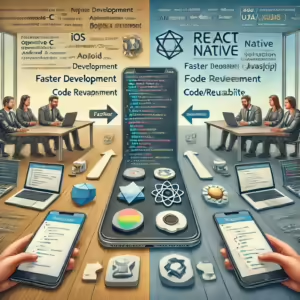The evolution of mobile app development has been rapid and transformative. As businesses increasingly seek to serve a global audience, the demand for applications that function across multiple platforms has surged. Traditional native development—where apps are written separately for iOS and Android using platform-specific languages—can often become resource-intensive and time-consuming. This is where cross-platform frameworks like React Native come into play. By adopting a cross-platform approach, businesses can achieve greater development efficiency, code reusability, and cost savings, all while maintaining a consistent user experience.
In this article, we explore the process of transitioning from native development to React Native or a similar UI framework, and how Curate Consulting Services can support your business by providing specialized talent to manage this complex migration effectively.
Understanding the Benefits of Moving to React Native
Moving from native app development to a cross-platform framework such as React Native offers significant advantages, especially for businesses looking to expand their reach without duplicating effort. React Native allows developers to write a single codebase in JavaScript, which can then be deployed on both iOS and Android platforms.
For both B2B and B2C audiences, the key benefits include:
-
Code Reusability:
- Instead of maintaining two separate codebases for iOS (Objective-C/Swift) and Android (Java/Kotlin), businesses can use a single codebase, reducing redundancy and lowering maintenance costs.
-
Faster Development Cycles:
- With a single development process for both platforms, the overall development cycle is shortened. This allows businesses to release features and updates more quickly, keeping up with market demands.
-
Broader Market Reach:
- Cross-platform apps can easily target a wider user base by simultaneously launching on both iOS and Android. This leads to faster adoption and higher user engagement across multiple platforms.
These benefits come with certain trade-offs and challenges, which we will address in this guide. Curate Consulting Services can assist businesses by providing developers skilled in both native and React Native development, ensuring a smooth transition and helping you avoid common pitfalls along the way.
1. Evaluation and Planning: Setting the Stage
Before you embark on the migration, it’s critical to evaluate your current native app and the goals of the transition. Questions you should ask include:
- What are the primary drivers for moving to React Native? (e.g., faster development, maintenance simplicity, wider reach)
- How complex is the existing app, and which components can be reused in the new framework?
Choosing the right framework is equally important. While React Native is a popular choice, other frameworks like Flutter and Xamarin also offer cross-platform capabilities. React Native, however, boasts a large developer community, extensive third-party libraries, and tight integration with JavaScript—making it a strong choice for businesses already familiar with this language.
Curate Consulting Services offers strategic guidance in this phase. Our consultants can help assess your current app, determine the scope of migration, and align the choice of technology with your business objectives. Additionally, we can provide specialized talent that understands the technical nuances of cross-platform frameworks, ensuring that your migration plan is both sound and practical.
2. Assessing and Training Your Development Team
One of the most important steps in transitioning from native to React Native is evaluating the skills of your development team. If your team has a background in JavaScript, the transition to React Native will be smoother. However, if they’ve been working exclusively with native languages, additional training may be necessary.
At Curate, we specialize in finding specialized talent with the precise skills you need. Whether your team requires upskilling or you need to onboard experienced React Native developers, we can source experts who bring in-depth knowledge of cross-platform frameworks and mobile app architecture. This allows you to maintain momentum throughout the transition without significant delays.
3. Codebase Analysis: What Can Be Reused?
The next step involves a detailed analysis of your existing native codebase. One of the primary goals of moving to React Native is reusing as much of your business logic, data models, and components as possible. However, some components—especially those tightly coupled with platform-specific features—may need to be rewritten.
What Can Be Reused:
- Business Logic: Any non-UI code that handles data processing, API calls, and application logic can often be reused with little modification.
- Data Models: Since React Native supports many of the same data storage and retrieval methods, most of your data models can be carried over.
What Needs to Be Rewritten:
- UI Components: React Native uses its own components to render the UI, so any UI written in Swift, Objective-C, Java, or Kotlin will need to be adapted to the React Native framework.
- Platform-Specific Code: Features like push notifications, camera access, and geolocation might still require platform-specific implementations. However, React Native provides native modules that allow these components to be integrated smoothly.
4. Designing and Architecting the New App
As you move from native to React Native, consider how the app’s architecture will change. Native apps often follow architecture patterns like MVC (Model-View-Controller) or MVVM (Model-View-ViewModel). React Native apps, however, typically rely on a component-based architecture where each UI component is isolated and reusable.
UI/UX Considerations:
- Responsive Design: Since React Native apps run on both iOS and Android, UI components need to be designed for varying screen sizes and resolutions.
- Navigation Patterns: Native iOS and Android apps have distinct navigation experiences. React Native offers libraries like React Navigation to bridge the gap, but some platform-specific navigation nuances may still require customization.
At this stage, Curate can provide UI/UX designers skilled in crafting interfaces that work seamlessly across platforms. Our talent pool also includes mobile architects who can help design an app architecture that optimizes performance while adhering to best practices for cross-platform development.
5. Development and Platform-Specific Code
The actual development process will likely involve a mix of rewriting components and adapting existing code to the new framework. Developers will need to refactor parts of the app to fit React Native’s component model, while maintaining some platform-specific code when necessary. For example, you might still need to write native code in Swift or Kotlin to handle features that aren’t fully supported by React Native.
6. Testing and Optimization
Testing a cross-platform app can be more complex than testing a native app. You’ll need to ensure that the app works correctly on both iOS and Android devices, while also keeping an eye on performance bottlenecks. Tools like Jest for unit testing and React Native’s own debugging tools can help ensure that your app runs smoothly.
Performance optimization is critical for ensuring that your app provides a native-like experience. This includes optimizing animations, memory usage, and load times, particularly on lower-end devices.
7. Deployment and Maintenance
Deploying a React Native app requires a different approach than deploying a native app. You’ll need to package and submit your app to both the Apple App Store and Google Play Store, following each platform’s specific guidelines.
Once your app is live, maintenance is key. React Native apps, like all mobile apps, require ongoing updates as new versions of iOS and Android are released. Curate Consulting Services can provide ongoing support, ensuring your app remains up-to-date and compatible with new platform features.
Conclusion: A Smarter Path Forward with React Native
Transitioning from native development to React Native offers businesses a smarter, more efficient way to develop mobile applications for multiple platforms. The process requires careful planning, codebase evaluation, and a skilled development team, but the rewards in terms of reduced maintenance costs, faster development cycles, and broader market reach are substantial.
At Curate Consulting Services, we provide the expertise and talent needed to make this transition as smooth and successful as possible. Whether you need mobile architects, React Native developers, or UX designers, we can deliver the specialized talent required to help you meet your goals and ensure that your app performs seamlessly across platforms.

